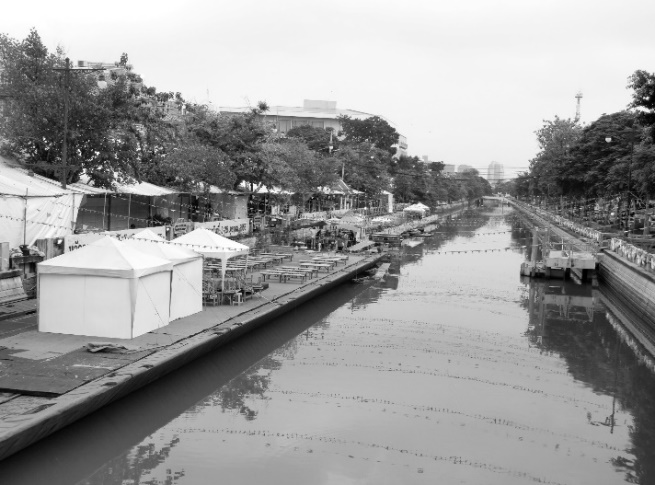Analyzing the Floating Market System in Thailand for Sustainability
Main Article Content
Abstract
Humans and water share a close relationship in Thailand. Before modernization, Thailand had many canals, a developed water traffic system, and many floating markets. These markets functioned as community spaces for the inhabitants. Moreover, environmental sustainability had been reached and the system seemed important to the culture. In this work, the remaining floating markets in and around Bangkok are surveyed and then compared. The results are as follows.
Bangkok has 28 floating markets, as of 2016. These markets can be divided into three types based on their “target customers.” Some markets used a temple site because temples function as community spaces for the local inhabitants; others are only meant for sightseeing and do not function as community spaces. Based on their contribution to the “local economy,” these markets can be divided into three types. The type of market differed according to location. The markets where anything is sold, however, are not useful to the local economy. The floating markets can be divided into four types based on their “space composition.” These markets are cool spaces, a characteristic of water spaces. Based on their “waterway network,” these markets can be divided into three types. Markets at closed sites are not connected to other places because they are only meant for tourists.
Consequently, “target customers,” “local economy,” “space composition,” and “waterway network” are determined as necessary factors in considering a sustainable floating market system in the present and future. This study contributes to adopting a sustainable development concept of a floating market in attracting policymakers and local people to draw tourist appeal.
Downloads
Article Details

This work is licensed under a Creative Commons Attribution-NonCommercial-NoDerivatives 4.0 International License.
All material is licensed under the terms of the Creative Commons Attribution 4.0 International (CC-BY-NC-ND 4.0) License, unless otherwise stated. As such, authors are free to share, copy, and redistribute the material in any medium or format. The authors must give appropriate credit, provide a link to the license, and indicate if changes were made. The authors may do so in any reasonable manner, but not in any way that suggests the licensor endorses you or your use. The authors may not use the material for commercial purposes. If the authors remix, transform, or build upon the material, they may not distribute the modified material, unless permission is obtained from JARS. Final, accepted versions of the paper may be posted on third party repositories, provided appropriate acknowledgement to the original source is clearly noted.
References
Batra, A. (2014). Floating market: Balancing the needs of visitors as a tourists attraction and locals way of life- a case study of Talingchan floating market, Bangkok, Thailand. World Applied Sciences Journal 30 (Innovation Challenges in Multidisciplinary Research & Practice), 332-343, 2014.
Buasorn, P. (2010). The revitalization of old markets in Thailand. (Ph.D. Dissertation). Silpakorn University, Thailand.
Denpaiboon, C. (2001). Transformation by modernization of the traditional waterfront settlements in the context of their coexistence with the aquatic environment: A case study of raft houses and pillar houses in Thailand. (Ph.D. Dissertation). Kyoto University, Japan.
Fleisher, J. (n.d.). How public space is used in ancient cities: The case of Songo Mnara, a medieval Swahili city in Tanzania. Retrieved from: https://www.google.co.th/url?sa=t&rct=j&q=&esrc=s&source=web&cd=1&cad=rja&uact=8&ved=0ahUKEwjyx_S6rdvKAhXYW44KHWtfB5EQFggaMAA&url=http%3A%2F%2Fkinder.rice.edu%2FuploadedFiles%2FKinder_Institute_for_Urban_Research%2FPeople%2FResearch_Fellows%2FFleisher%2520Kinder%2520White%2520Paper.pdf&usg=AFQjCNFtcgB33VsdE3dnrEZQzK9YgoQRfg&sig2=Q2mD2h_S8kAENfo04pZR2w&bvm=bv.113034660,d.c2E.
Prasertsuk, S. (2015). Architectural composition for utilities and spatial connection in modern Thai architecture. Journal of Architecture/Planning Research and Studies, 12(1), 42.
Yasmeen, G. & Nirathron, N. (2014). Vending in public space: The case of Bangkok. WIEGO Policy Brief (Urban Policies), No. 16, Cambridge, MA.7. AcknowledgementsIn completing this article, there are many individuals who have helped and supported me during staying in Thailand for 1 year, and to whom I wish to express my deepest and most sincere gratitude. First, Faculty of Architecture and Planning for accept me as a Visiting Professor, studying and writing an article during staying there. My thanks go to faculty members such as Assoc. Prof. Dr. Chaweewan Denpaiboon for giving me excellent advice concerning a Thai Folk Architecture and study tour for surveying Floating Market in the Central part of Thailand, Assoc. Prof. Santrirak Prasertsuk and Assist Prof. Khiensak Seangklieng for his fine advice in my study.
Fleisher, J. (n.d.). How public space is used in ancient cities: The case of Songo Mnara, a medieval Swahili city in Tanzania. Retrieved from: https://www.google.co.th/url?sa=t&rct=j&q=&esrc=s&source=web&cd=1&cad=rja&uact=8&ved=0ahUKEwjyx_S6rdvKAhXYW44KHWtfB5EQFggaMAA&url=http%3A%2F%2Fkinder.rice.edu%2FuploadedFiles%2FKinder_Institute_for_Urban_Research%2FPeople%2FResearch_Fellows%2FFleisher%2520Kinder%2520White%2520Paper.pdf&usg=AFQjCNFtcgB33VsdE3dnrEZQzK9YgoQRfg&sig2=Q2mD2h_S8kAENfo04pZR2w&bvm=bv.113034660,d.c2E.
Prasertsuk, S. (2015). Architectural composition for utilities and spatial connection in modern Thai architecture. Journal of Architecture/Planning Research and Studies, 12(1), 42.
Waralak, K. (2016). Non-motorized transportation in and around Sri Nakhon. Journal of Architectural/Planning Research and Studies, 13(1), 61-73.
Yasmeen, G. & Nirathron, N. (2014). Vending in public space: The case of Bangkok. WIEGO Policy Brief (Urban Policies), No. 16, Cambridge, MA.


